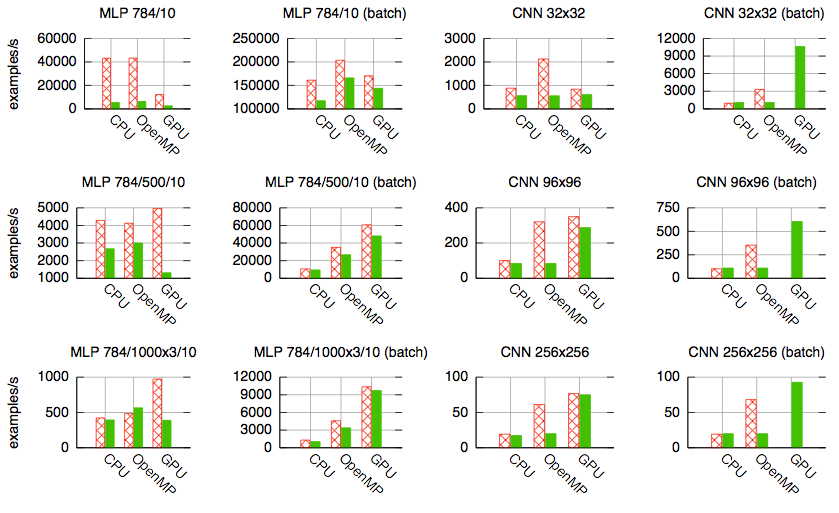Torch vs Theano
2015-07-14 19:09
435 查看
Torch vs Theano
Recently we took a look at Torch 7 and found its data ingestion facilities less than impressive. Torch’s biggest competitor seems to be Theano, a popular deep-learning framework for Python.It seems that these two have been having “who is faster” competition going for a few years now. It’s been documented in the following papers:
J. Bergstra, O. Breuleux, F. Bastien, P. Lamblin, R. Pascanu, G. Desjardins, J. Turian, Y. Bengio - Theano: a CPU and GPU Math Expression Compiler PDF
Ronan Collobert, Koray Kavukcuoglu, Clement Farabet - Torch7: A Matlab-like Environment for Machine Learning PDF
Frédéric Bastien, Pascal Lamblin, Razvan Pascanu, James Bergstra, Ian Goodfellow, Arnaud Bergeron, Nicolas Bouchard, David Warde-Farley, Yoshua Bengio - Theano: new features and speed improvements arxiv

A figure from the Torch7 paper [2]. Torch - red, Theano - green. Higher is better.
And a quote from [3]:
Bergstra et al.(2010) showed that Theano was faster than many other tools available at the time, including Torch5. The following year, Collobert et al.(2011) showed that Torch7 was faster than Theano on the same benchmarks.
The results in the last paper are mixed, if you’re wondering.
The latest act in this friendly competition, which can be seen as one between Bengio’s and LeCun’s groups, appears to be about FFT convolutions, first available in Theano and recently open-sourced by Facebook in Torch.
As a side note, the press really jumped at this second event with headlines about turbo-charging deep learning and the like. Probably the allure of Facebook and deep learning in the same sentence.
Let’s look at convnet benchmarks by Soumith Chintala. He is a Facebook/Torch guy and yet the Theano’s convolution layer is reported to be the fastest at the time of writing. Waiting for those fbfft results.
Anyway, speed isn’t everything and there’s more to life than FFT convolutions. From a developer’s perspective minor differences in speed are less important than other factors, like ease of use. Which leads us to what Soumith had to say about Torch, according to VentureBeat:
It’s like building some kind of electronic contraption or, like, a Lego set. You just can plug in and plug out all these blocks that have different dynamics and that have complex algorithms within them.
At the same time Torch is actually not extremely difficult to learn — unlike, say, the Theano library.
We’ve made it incredibly easy to use. We introduce someone to Torch, and they start churning out research really fast.
Well, you already know our opinion about the “incredibly easy” bit. Torch is not really a Matlab-like environment. Matlab, with all its shortcomings, is a very well polished piece of software with examplary documentation. Torch, on the other hand, is rather rough around the edges.
Besides the language gap, that’s one of the reasons that you don’t see that much Torch usage apart from Facebook and DeepMind. At the same time libraries using Theano have been springing up like mushrooms after a rain (you might want to take a look at Sander Dieleman’s Lasagne and at blocks). It is hard to beat the familiar and rich Python ecosystem.
Theano tutorials
The official tutorialAlec Radford’s talk and corresponding code
Colin Raffel’s tutorial notebook
The Portrait of a Machine Learning Priestess
Best framework for Deep Neural Nets thread at Reddit
P.S. What about Caffe?
Caffe is a fine and very popular piece of software. How does it compare with Torch and Theano? Here’s sieisteinmodel’s answer from Reddit:Caffe has a pretty different target. More mass market, for people who want to use deep learning for applications. Torch and Theano are more tailored towards people who want to use it for research on DL itself.
相关文章推荐
- 性能测试积累
- C5_二维数组练习
- hashMap的遍历
- java中的书写规范、条件运算符、循环语句
- gdb显示完整字符串
- Android-编译环境搭建(多版本JDK切换)
- Leetcode-Permutations II
- Cocos2D-x 入门(3) ---基本概念
- android- Auto Monitor Logcat
- android LocalActivityManager说明
- SSL构建单双向https认证!https部署及注意事项!
- POJ3250 Bad Hair Day 单调栈
- c++11 右值引用与转移语义
- Linux中profile、bashrc、bash_profile之间的区别和联系
- C5_二维数组
- iOS 开发常用宏
- What does it mean for an algorithm to be fair
- java程序执行外部命令
- IOS开发 -11.KVO
- OC总结
